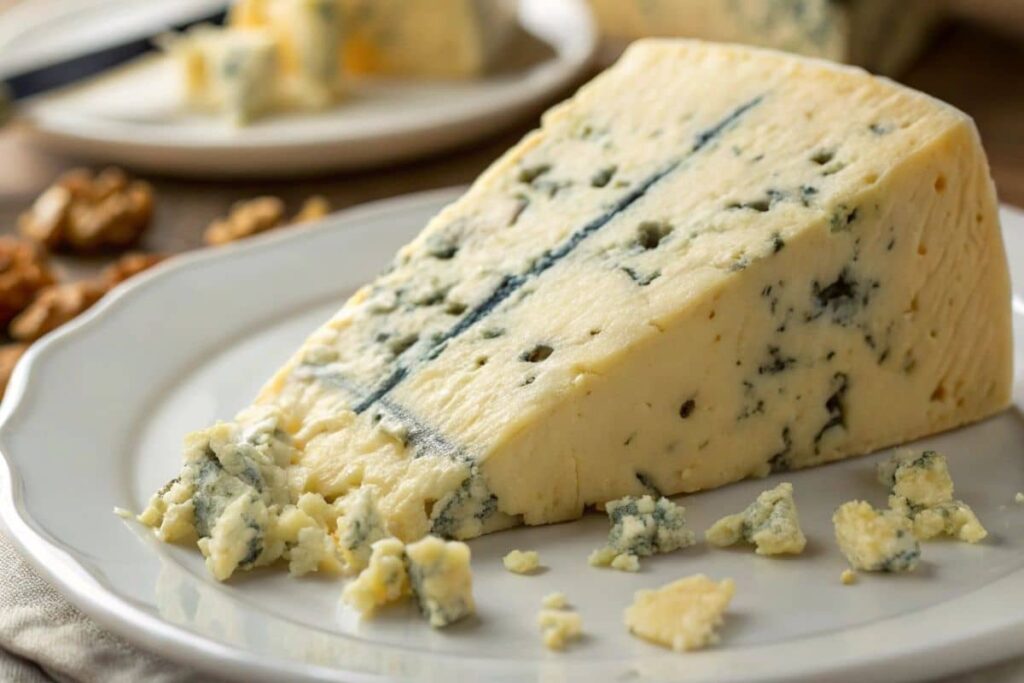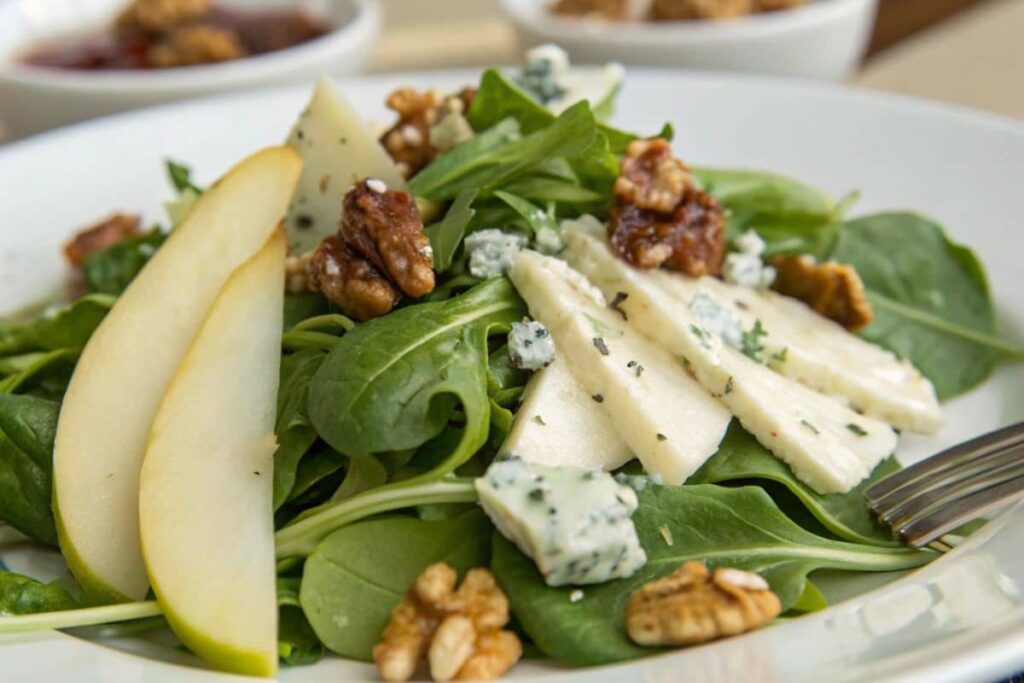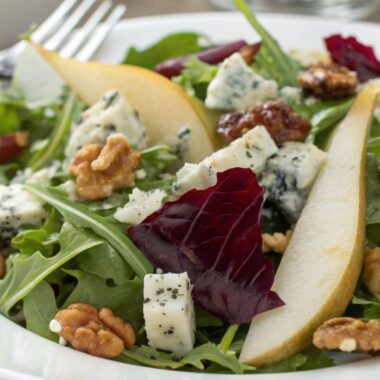If you’ve ever seen blue cheese in a store, you’ve probably wondered: “What’s the deal with those blue veins?” Blue cheese, also known as Roquefort, is certainly one of the most distinctive cheeses out there, known for its bold, tangy taste and strong aroma. Some people love it, while others can’t stand it. But what makes blue cheese so special?
In this article, we’ll explore the history, flavors, and benefits of blue cheese. You’ll also discover why this unique cheese is worth a second (or third!) try. So, let’s dive into the world of blue cheese and see what all the fuss is about!
Table of Contents

ABrief History of Roquefort
Roquefort has a fascinating history, dating back to ancient times. It is believed to have originated in France, particularly in the Roquefort region. Legend has it that a French shepherd accidentally discovered this unique cheese when he left a piece in a cave, only to return and find it covered in mold. Instead of discarding it, he decided to taste it—and found it surprisingly delicious! Over time, this mold-ripened cheese spread throughout Europe, inspiring different variations.
Origins and Evolution of Roquefort
The earliest known form of this cheese is Roquefort, traditionally made in southern France from sheep’s milk. As time passed, similar cheeses were developed in different regions, each incorporating unique aging techniques. Today, Roquefort remains one of the most famous mold-ripened cheeses, valued for its bold flavor and creamy texture.
Key Roquefort Varieties
Some popular blue-veined cheeses related to Roquefort include:
- Roquefort (France): Sharp, tangy, and creamy.
- Gorgonzola (Italy): Milder, creamier with earthy flavors.
- Stilton (England): Strong, crumbly with a sharp taste.
Each variety has its own distinct characteristics, making them unique in both texture and flavor.
What Exactly Is Roquefort?
Roquefort stands out from other cheeses due to its special ingredient—mold! To make it, the cheese is inoculated with Penicillium roqueforti mold, which forms blue-green veins throughout the cheese as it ages. This mold is responsible for Roquefort’s intense flavor and distinctive appearance.
How It’s Made
The process starts with traditional cheese-making methods, followed by adding the mold spores. The cheese is then aged in cool, damp caves, allowing the mold to develop its iconic veining and bold taste.
The Role of Mold in Roquefort
The Penicillium roqueforti mold plays a crucial role in shaping the flavor and texture of Roquefort. It helps break down proteins and fats, resulting in a creamy consistency and rich taste. The longer Roquefort ages, the more intense and pungent its flavor becomes.
The Flavor Profile of Roquefort
Roquefort has a unique and bold taste, often described as tangy, creamy, and earthy. The mold contributes to its sharpness and adds complexity to its flavor. Depending on the aging process, Roquefort can range from mildly tangy to intensely sharp.
Taste: Bold, Tangy, and Complex
The flavor of Roquefort is one of the reasons people either love it or dislike it. It is often strong, salty, and creamy, with a bold tanginess that makes it stand out. Some find it overpowering, while others crave its unique intensity.
Aroma: Why Is It So Strong?
Roquefort has a strong, distinctive aroma, which comes from the breakdown of fats and proteins during the aging process. While some find the smell intense, it is part of what makes Roquefort such a unique and highly valued cheese.
The Nutritional Benefits of Blue Cheese
Blue cheese might be famous for its bold flavor and distinctive appearance, but did you know it has some surprising nutritional benefits too? While it’s often thought of as a guilty pleasure, blue cheese can actually be a healthy addition to your diet when consumed in moderation.
High in Protein and Calcium
Like many other cheeses, blue cheese is a great source of protein. Protein is essential for muscle growth and repair, which makes it a valuable nutrient for anyone, especially for those who are active. Additionally, blue cheese is packed with calcium, which is crucial for building and maintaining strong bones and teeth. So, a little blue cheese on your salad or sandwich could give you a nice boost of these important nutrients.
Is Blue Cheese Good for Your Health?
While blue cheese does have some health benefits, it’s important to be mindful of the fact that it’s also high in fat and calories. This doesn’t necessarily mean it’s bad for you, but it’s best to enjoy it in moderation. On the plus side, blue cheese contains probiotics, which are good bacteria that support your digestive system. These probiotics can help keep your gut healthy, contributing to overall wellness.
Additionally, blue cheese contains vitamins like A and K, which support skin health and improve blood clotting. So, while it’s not exactly a superfood, blue cheese can still offer some nutritional perks as part of a balanced diet.
Common Problems with Roquefort
As much as we love Roquefort, it’s not without its challenges. Whether it’s the strong flavor or storage issues, there are some common problems people face when enjoying this unique cheese.
Overpowering Flavor: How to Tone It Down
Roquefort has a very strong flavor that some find overpowering. If you’re new to it or find it too pungent, try pairing it with milder foods like fresh fruits or mild crackers. Sweet fruits such as pears or apples can balance the sharpness, while combining it with a mild cheese like cream cheese or mozzarella can help tone down its intensity.
Allergies: Can Roquefort Cause Reactions?
Some people may have allergic reactions to Roquefort, especially those allergic to mold. While Penicillium roqueforti (the mold used in Roquefort) is generally safe for most, those with mold allergies should avoid it. If you’re unsure, it’s best to check with your doctor.
How to Pair Blue Cheese Like a Pro
Pairing Roquefort with the Right Foods
Pairing Roquefort with the right foods can elevate your meal and highlight its bold flavor. Whether adding it to a salad or serving it on a cheese board, the right pairings make all the difference.
Best Wine Pairings for Roquefort
Roquefort and wine make a classic combination, but not all wines work well. Bold reds like Cabernet Sauvignon or Port are perfect, as their rich flavors balance Roquefort’s sharpness. For white wine lovers, try a dessert wine like Sauternes, whose sweetness contrasts nicely with the tangy, salty notes of Roquefort.
Ideal Food Pairings: From Meats to Fruits
Roquefort also pairs well with a variety of foods. For a simple snack, enjoy it with crackers or fresh bread. It pairs beautifully with fruits like figs, apples, or pears, as their sweetness balances Roquefort’s saltiness. You can also experiment by adding it to salads, burgers, or pasta dishes for an extra layer of flavor.
Cooking with Roquefort: Creative Recipes
Roquefort isn’t just for snacking or cheese boards—it can be incorporated into a variety of dishes, adding its bold flavor to everything from salads to sauces. Here are a few creative ways to use Roquefort in your cooking.
Roquefort Dressing: A Classic Favorite
One of the best ways to enjoy Roquefort is in the form of Roquefort dressing. This creamy, tangy dressing is perfect for dipping veggies, drizzling over salads, or topping a juicy steak. To make it, simply combine crumbled Roquefort, sour cream, mayonnaise, a bit of vinegar, and some seasonings. You can easily customize it with garlic, herbs, or a touch of hot sauce for extra flavor.

Roquefort in Pasta, Salads, and More
Roquefort also works well in pasta dishes and salads. Add crumbled Roquefort to a salad for a sharp, creamy bite. For pasta, melt it into a creamy sauce for a rich, indulgent dish. You can also mix it into mashed potatoes, burgers, or use it as a pizza topping for something a little different.
Is Roquefort Safe to Eat? Understanding Storage and Shelf Life
While Roquefort is delicious, it’s important to store it properly to avoid spoilage. Like all cheeses, it can go bad if not kept correctly.
How to Properly Store Roquefort
Roquefort should be kept in the fridge, wrapped tightly in wax or parchment paper. Place it in an airtight container to maintain freshness. For optimal texture and flavor, store Roquefort in a cool, humid environment, like a cheese drawer or dedicated storage container.
Can You Eat Expired Roquefort?
Roquefort, like other cheeses, has a shelf life. If it starts to develop an off smell or has mold that doesn’t look like the usual blue veins, it’s best to discard it. However, if stored properly and within the recommended time, Roquefort can be enjoyed even after its “best by” date—just be sure to inspect it carefully before eating.
Roquefort Controversies: Is It Really an Acquired Taste?
Roquefort is one of those foods that people either love or hate. It’s strong, pungent, and sometimes overpowering for those who aren’t used to it. But is it truly an acquired taste? For some, it’s all about the complex flavor, while others can’t get past the sharpness and strong aroma.
Common Criticisms of Roquefort
One of the main reasons people avoid Roquefort is its powerful smell. Earthy, musty, and sometimes overwhelming, its aroma can be a dealbreaker, especially for those not accustomed to it. Its sharp, salty flavor also isn’t for everyone. However, for Roquefort lovers, its boldness is what makes it special.
Why Some People Love It, and Others Hate It
For Roquefort fans, it’s all about the rich, tangy flavor and creamy texture paired with a salty kick. But if you prefer milder flavors, Roquefort might not be for you. Like strong flavors such as coffee or olives, it’s an acquired taste, and not everyone will enjoy it.
Recipe: Blue Cheese Salad Dressing
If you want to try blue cheese in a milder form, here’s a simple recipe for Blue Cheese Salad Dressing that’s perfect for beginners or those who want to enjoy the flavor without the full intensity of the cheese on its own.
Ingredients:
- 1/2 cup crumbled blue cheese
- 1/2 cup mayonnaise
- 1/4 cup sour cream
- 2 tbsp lemon juice or vinegar
- 1 small garlic clove, minced
- Salt and pepper to taste
Instructions:
- In a bowl, combine the crumbled blue cheese, mayonnaise, and sour cream. Mix until smooth.
- Add the lemon juice or vinegar to give the dressing a bit of tang.
- Stir in the minced garlic, and season with salt and pepper to taste.
- Chill in the fridge for about 30 minutes before serving to allow the flavors to blend.
- Serve over a fresh salad or as a dip for veggies or wings.
FAQ: All About Blue Cheese
1. What is blue cheese?
roquefort is a type of cheese that has blue or green veins running through it. These veins are caused by the mold Penicillium roqueforti, which is introduced during the cheese-making process. The mold gives the cheese its distinctive flavor and appearance.
2. Why does blue cheese smell so strong?
Blue cheese has a strong, musty aroma due to the breakdown of proteins and fats as the cheese ages. The mold used to create the blue veins produces compounds that contribute to the pungent smell, which is part of the cheese’s unique character.
3. Is blue cheese safe to eat?
Yes, blue cheese is generally safe to eat for most people. However, if you’re allergic to mold, it’s best to avoid it. Pregnant women should also consult their doctors before eating roquefort, as it’s a soft cheese that may carry some risk of bacteria, although many blue cheeses are pasteurized to reduce this risk.
4. What are the health benefits of blue cheese?
Blue cheese is a good source of protein, calcium, and vitamins like A and K. It also contains probiotics, which can support digestive health. However, because it’s high in fat and sodium, it’s best consumed in moderation.
5. Can blue cheese be used in cooking?
Absolutely! Blue cheese is great for adding flavor to dishes like salads, pasta, burgers, or even mashed potatoes. It can also be melted into sauces or used in dressings, like the roquefort Salad Dressing recipe above.
6. How should I store blue cheese?
Blue cheese should be stored in the fridge, wrapped tightly in wax paper or parchment paper and placed in an airtight container. This helps preserve the cheese’s texture and flavor while preventing it from drying out or absorbing other odors from the fridge.
7. How long does blue cheese last?
Blue cheese typically lasts about 1 to 3 weeks after opening, depending on the variety and how it’s stored. Always check for signs of mold growth (not the usual blue veins) or a change in smell before consuming.
8. How do I pair blue cheese with other foods?
Blue cheese pairs well with a variety of foods. Some classic pairings include crackers, fresh fruits like pears and apples, and wines such as Cabernet Sauvignon or dessert wines like Sauternes. It also works wonderfully in salads, on burgers, or as part of a cheese board.
9. Can I eat blue cheese if I’m lactose intolerant?
roquefort is lower in lactose compared to other dairy products, as much of the lactose is broken down during the fermentation process. However, if you’re highly sensitive to lactose, it’s best to check with your doctor before consuming blue cheese.
10. What’s the best way to start eating blue cheese if I’ve never had it before?
Start by adding small amounts of blue cheese to dishes like salads or sandwiches. You can also try it in milder forms, like in a dressing or blended into a sauce, to help you adjust to its flavor gradually.
Conclusion
Blue cheese offers more than just a bold flavor; it can also be beneficial for your gut, thanks to the probiotics it contains. These good bacteria can support digestive health, making roquefort a tasty addition to a balanced diet. If you’re wondering whether you can freeze blue cheese, the answer is yes! However, freezing can affect its texture, so it’s best used in cooked dishes after freezing. As for its shelf life, roquefort typically lasts about 1 to 3 weeks in the fridge, depending on storage conditions. Always check for any changes in smell or mold before consuming.
For more detailed answers, you can check out our article on Is Blue Cheese Good for Your Gut?, learn about How Long Blue Cheese Lasts in the Fridge. Also, if you’re looking for fresh and delicious alternatives, check out some tasty Cottage Cheese Recipes for a lighter option! 🧀





